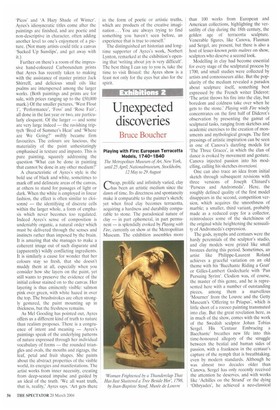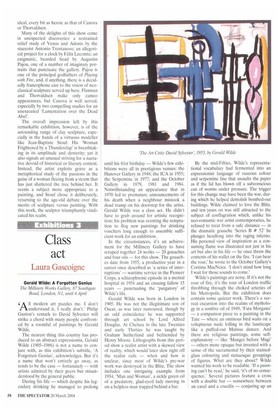Unexpected discoveries
Bruce Boucher
Playing with Fire: European Terracotta Models, 1740-1840
The Metropolitan Museum of Art, New York, until 25 April; Nationalmuseum, Stockholm, 12 May to 29 August
Cheap, prolific and infinitely varied, clay V./has been an artistic medium since the dawn of time. Its directness and spontaneity make it comparable to the painter's sketch; yet when fired clay becomes terracotta, acquiring a hardness and durability comparable to stone. The paradoxical nature of clay — in part ephemeral, in part permanent — is splendidly evoked by Playing with Fire, currently on show at the Metropolitan Museum. The exhibition assembles more than 100 works from European and American collections, highlighting the versatility of clay during the 18th century, the golden age of terracotta sculpture. Venerable figures, like Canova, Flaxman and Sergel, are present, but there is also a host of lesser-known petits maitres on show, sculptors who deserve a second look.
Modelling in clay had become essential for every stage of the sculptural process by 1700, and small studies were collected by artists and connoisseurs alike. But the popularity of the medium revealed a paradox about sculpture itself, something best expressed by the French writer Diderot: The artist throws his fire into the clay, but boredom and coldness take over when he gets to the stone.' Playing with Fire wisely concentrates on the first half of Diderot's observation by presenting the gamut of sculptural tasks, ranging from sketches and academic exercises to the creation of monuments and mythological groups. The first pressings of artistic inspiration can be seen in one of Canova's dazzling models for 'The Three Graces', in which the élan of dance is evoked by movement and gesture. Canova injected passion into his modelling, calling his sketches invenzioni.
One can also trace an idea from initial sketch through subsequent revisions with three versions of Joseph Chinard's 'Perseus and Andromeda'. Here, the roughly defined quality of the first model disappears in the second, competition version, which acquires the smoothness of marble; a smaller, third variant, probably made as a reduced copy for a collector, reintroduces some of the sketchiness of the original while heightening the sensuality of Andromeda's expression.
The gods, nymphs and centaurs were the hardy perennials of the sculptor's studio, and clay models were prized like small bronzes during this period. Sometimes, an artist like Philippe-Laurent Roland achieves a graceful variation on an old theme with his 'Bacchante Riding a Goat' or Gilles-Lambert Godecharle with 'Pan Pursuing Syrinx'. Clodion was, of course, the master of this genre, and he is represented here with a number of outstanding pieces, among them a marvellous 'Mourner' from the Louvre and the Getty Museum's 'Offering to Priapus', which is little short of a rococo painting transmuted into clay. But the great revelation here, as in much of the show, comes with the work of the Swedish sculptor Johan Tobias Sergel. His 'Centaur Embracing a Bacchante' breathes new life into this time-honoured allegory of the struggle between the bestial and human sides of passion, with a frankness in the centaur's capture of the nymph that is breathtaking, even by modern standards. Although he was almost two decades older than Canova, Sergel has only recently received the attention he deserves, and with works like 'Achilles on the Strand' or the dying `Othryades', he achieved a neo-classical ideal, every bit as heroic as that of Canova or Thorvaidsen.
Many of the delights of this show come in unexpected discoveries: a restrained relief study of Venus and Adonis by the stuccoist Antonio Trentanove; an allegorical project for a clock by Felix Lecomte; an enigmatic, bearded head by Augustin Pajou, one of a number of imaginary portraits that punctuate the gallery. Pajou is one of the principal godfathers of Playing with Fire, and, if anything, there is a decidedly francophone cast to the vision of neoclassical sculpture served up here. Flaxman and Thorvaldsen make only cameo appearances, but Canova is well served, especially by two compelling studies for an unexecuted 'Lamentation over the Dead Abel'.
The overall impression left by this remarkable exhibition, however, is of the astounding range of clay sculpture, especially in the hands of a virtuoso modeller like Jean-Baptiste Stout His 'Woman Frightened by a Thunderclap' is breathtaking in its amplitude and dexterity; yet it also signals an unusual striving for a narrative devoid of historical or literary context. Instead, the artist exploits genre as a metaphorical study of the passions in the guise of a woman fleeing from a storm that has just shattered the tree behind her. It seems a subject more appropriate to a painting, and Stouf chose it deliberately, returning to the age-old debate over the merits of sculpture versus painting. With this work, the sculptor triumphantly vindicated his realm.



















































































 Previous page
Previous page